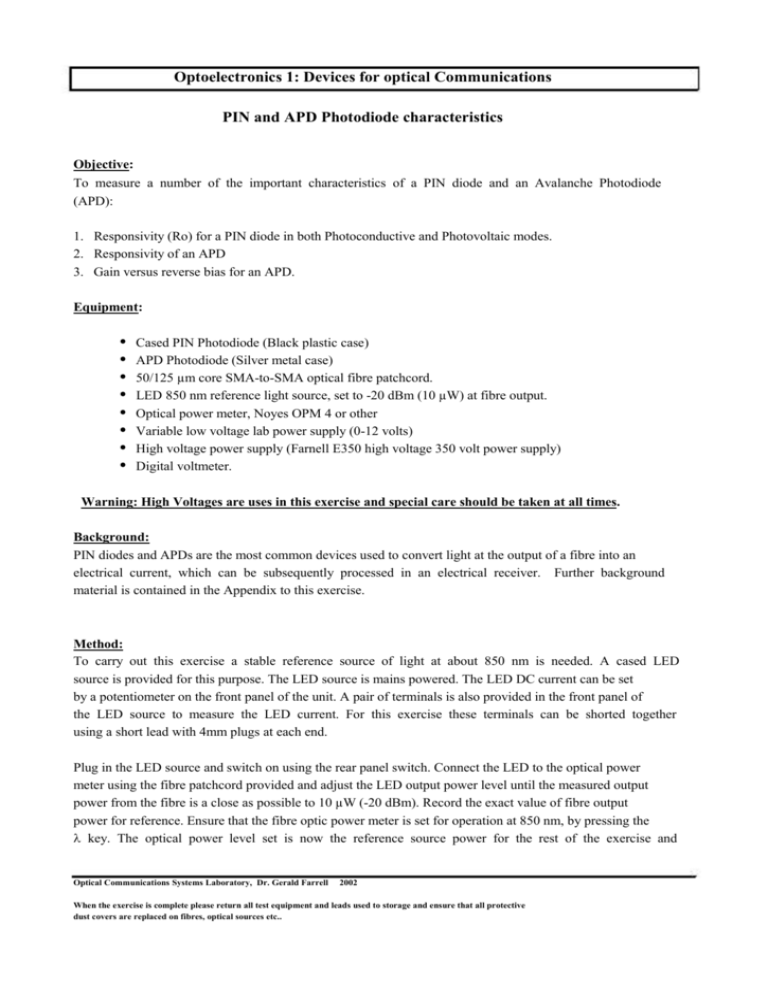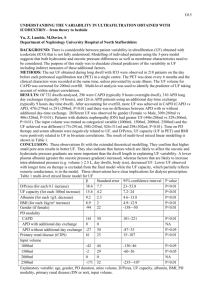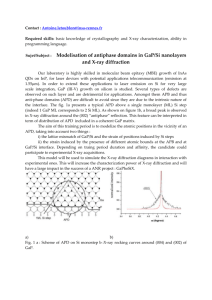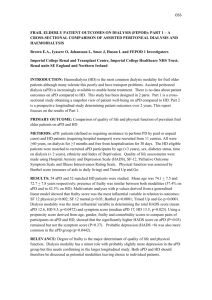PIN and APD Photodiode characteristics
advertisement

Optoelectronics 1: Devices for optical Communications PIN and APD Photodiode characteristics Objective: To measure a number of the important characteristics of a PIN diode and an Avalanche Photodiode (APD): 1. Responsivity (Ro) for a PIN diode in both Photoconductive and Photovoltaic modes. 2. Responsivity of an APD 3. Gain versus reverse bias for an APD. Equipment: • • • • • • • • Cased PIN Photodiode (Black plastic case) APD Photodiode (Silver metal case) 50/125 µm core SMA-to-SMA optical fibre patchcord. LED 850 nm reference light source, set to -20 dBm (10 µW) at fibre output. Optical power meter, Noyes OPM 4 or other Variable low voltage lab power supply (0-12 volts) High voltage power supply (Farnell E350 high voltage 350 volt power supply) Digital voltmeter. Warning: High Voltages are uses in this exercise and special care should be taken at all times. Background: PIN diodes and APDs are the most common devices used to convert light at the output of a fibre into an electrical current, which can be subsequently processed in an electrical receiver. Further background material is contained in the Appendix to this exercise. Method: To carry out this exercise a stable reference source of light at about 850 nm is needed. A cased LED source is provided for this purpose. The LED source is mains powered. The LED DC current can be set by a potentiometer on the front panel of the unit. A pair of terminals is also provided in the front panel of the LED source to measure the LED current. For this exercise these terminals can be shorted together using a short lead with 4mm plugs at each end. Plug in the LED source and switch on using the rear panel switch. Connect the LED to the optical power meter using the fibre patchcord provided and adjust the LED output power level until the measured output power from the fibre is a close as possible to 10 µW (-20 dBm). Record the exact value of fibre output power for reference. Ensure that the fibre optic power meter is set for operation at 850 nm, by pressing the key. The optical power level set is now the reference source power for the rest of the exercise and Optical Communications Systems Laboratory, Dr. Gerald Farrell 2002 When the exercise is complete please return all test equipment and leads used to storage and ensure that all protective dust covers are replaced on fibres, optical sources etc.. should not be altered again. Make sure also that the fibre is not under stress or tightly wound when taking the reference as this could make the reference setting invalid. 1. Responsivity for the PIN diode (Photoconductive and Photovoltaic modes). In the photoconductive mode the PIN photodiode is connected to the 12 V supply. The reference optical signal is connected to the PIN diode and the optically generated current in the PIN is measured by measuring the voltage across the 100 k resistor in series with the PIN diode (the voltage can be measured at the BNC connector). Calculate the output current from the PIN diode and hence calculate the Responsivity in A/W, based on the optical input power in W from the optical source. In the photovoltaic mode the PIN diode operates without an external DC supply. To measure the responsivity in this mode disconnect the 12 V supply and short circuit the red and black terminals on the PIN diode case (this effectively places the PIN diode in parallel with the 100 K resistor). Now measured the responsivity as above. The photoconductive responsivity should be slightly higher than the photovoltaic responsivity. Why? 2. Responsivity for the APD Using the same 12 volts supply used for the PIN diode measure the responsivity of the APD, in the same manner as the PIN diode (photoconductive mode). For an APD this measurment is carried out at a low voltage to ensure that no gain is present, since APD responsivity is normally defined as the value with the gain set to 1. The APD is contained in a metal case and is in series with a 1 k resistor. The current in the APD can be measured by measuring the voltage across this 1 k resistor, available at the BNC connector on the APD case. 3. APD gain voltage characteristic Connect the APD to the optical power source (set above) and to the high voltage bias supply, taking care not to touch leads etc. when the HV supply is on. For an applied bias voltage of about 30 volts measure the output voltage from the APD developed across an internal 1 k resistor and calculate the APD current, recording this value as the "NO-GAIN" current. Now increase the bias voltage in 20-30 volt steps and tabulate the output current from the APD in each case. Note that at some stage the output current will increase rapidly for small changes in the applied bias voltage. This means that the bias voltage is close to the breakdown voltage for the device. Do not exceed this operating point as damage to the APD could result. When you have completed the measurements find the gain at each bias voltage by dividing the APD output current at that bias voltage by the NO-GAIN value recorded above. Hence plot the gain versus voltage characteristic for the APD on graph paper. Results: Optical Communications Systems Laboratory, Dr. Gerald Farrell 2002 When the exercise is complete please return all test equipment and leads used to storage and ensure that all protective dust covers are replaced on fibres, optical sources etc.. Record all of the results listed in the paragraphs above. Compare your responsivity values with the typical values found in the literature for such devices. Optical Communications Systems Laboratory, Dr. Gerald Farrell 2002 When the exercise is complete please return all test equipment and leads used to storage and ensure that all protective dust covers are replaced on fibres, optical sources etc.. Background information on PIN and APD Photodiode characteristics 1. Optical detectors By definition photodetectors convert light signals to electrical signals which can then be processed further. For fiber optic applications photodetectors work at standard wavelengths around 850, 1330 and 1550 nanometers. Suitable photodiodes may be either Pin diodes or avalanche photo diodes (APD's). In either case the operating wavelength determines the material used, for example Si being employed at 800-900 nm and GE or alloys of In, GA, As and P at 1330 nm. Pin diodes and APD's are variations on a basic depletion layer photodiode in which reverse current is altered by absorption of light at the correct wavelength. APD's differ from Pin diodes in that APD's have gain so that with the correct circuitry better sensitivity can be achieved with APD's. 2. Definitions for Photodiodes: Quantum efficiency is defined for photodiodes as the fraction of incident photons having sufficient energy to liberate electrons. The symbol used is R and by definition it is dependent both on wave-length and photodiode material. Responsivity of a photodiode is a practical measure of output current for a given optical power input. It is defined as average output current divided by average incident optical power so its units are A/W. Photoconductive mode and Photovoltaic mode. A PIN diode can be operated with an external bias voltage (typically up to 15 V DC). Ths is called the photoconductive mode were optically generated carriers are swept out of the device as a current under the influence of the externally applied field. In the photovoltaic mode no external bias is applied and the carriers are swept out of the device to form an external current by the internal depletion field in the device. Gain is the multiplication of the primary photon current. Gain exists in APD's only and is defined as the ratio of the output current at an operating voltage to the current at a low voltage where the gain is unity, that is no multiplication occurs. In effect, the primary photon current is multiplied by collision ionisation in a high field area. A typical gain characteristic is shown below: Breakdown Voltage 1000 100 10 1 1 10 100 Gain versus reverse bias voltage for an Avalanche Photodiode Dark Current In the absence of light a small dark current flows in a photodiode which is caused by leakage in the reverse biased photodiode. It has a very small effect in the performance of a receiver in terms of sensitivity and is ignored in any further analysis. It has been shown that dark currents less than 0.l nA have very little effect. Finally photodiodes normally exhibit rise and fall times less than one nano-second. In APD's the depletion capacitance increases rapidly below a certain reverse bias voltage; so to maintain fast rise and fall times a minimum bias voltage is maintained. Optical Communications Systems Laboratory, Dr. Gerald Farrell 2002 When the exercise is complete please return all test equipment and leads used to storage and ensure that all protective dust covers are replaced on fibres, optical sources etc.. Optical Communications Systems Laboratory, Dr. Gerald Farrell 2002 When the exercise is complete please return all test equipment and leads used to storage and ensure that all protective dust covers are replaced on fibres, optical sources etc..








